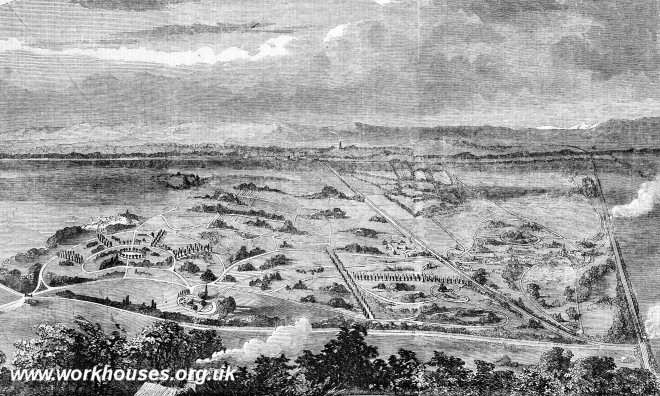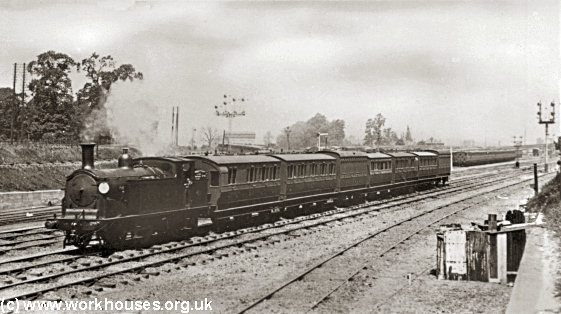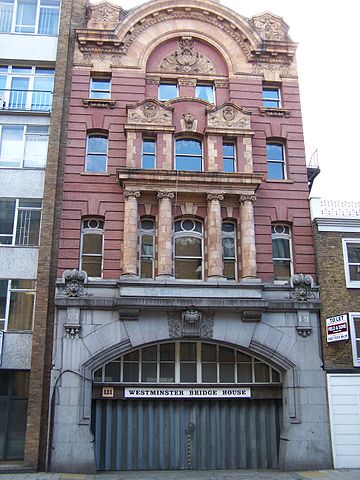The London Necropolis (Brookwood Cemetery) Woking, Surrey
By the 1840s, many of London's old parish graveyards had beome full to bursting point and an increasing health hazard, particularly to those living nearby. In 1850, a campaign led by public health reformers such as Dr Joseph Rogers resulted in legislation for the forcible closure of these graveyards. In 1856, Rogers became the medical officer at the Strand union workhouse on Cleveland Street where the parish of St Paul, Covent Garden, had a burial ground — recently closed — dating back to the 1770s. When excavations were made to build a new laundry on the site, he discovered that the builders had to dig through twenty feet of bones in order to reach solid ground for the foundations.
To provide a new resting place for London's dead, a number of privately operated out-of-town cemeteries were set up. One of the first and most ambitious of these schemes was the London Necropolis opened in 1854 at Brookwood, near Woking in Surrey, some twenty-five miles from the capital. Brookwood's 2,000-acre site was, at the time, the largest burial ground in the world with enough space, it was said, to bury all London's dead for the next 500 years.

An illustration of Brookwood Cemetery, 1856.
Brookwood ran its own funeral train service from a terminal at Waterloo, with a private branch-line to the cemetery's own two small stations.

A funeral train en route to Brookwood, 1902.
© Peter Higginbotham.

The remains of the entrance to the Necropolis railway terminus at Waterloo.
(Copyright details)
Many London workhouses, hospitals and prisons had contracts with Brookwood to bury inmates whose bodies had not been claimed after death. A list of these is given below:
| Workhouses | |
|---|---|
| City of London Union Workhouse | 1859 onwards |
| Holborn Union Workhouse | 1858 onwards |
| Lambeth Workhouse | 1858 onwards |
| Newington Workhouse, Walworth | 1856 onwards |
| St George's Hanover Square Workhouse | 1857 onwards |
| St George's Southwark Workhouse | 1856-1920 |
| St Giles in the Fields Workhouse | 1857 onwards |
| St Luke's Workhouse, Chelsea | 1858 onwards |
| St Margaret & St John, Westminster - Kensington Workhouse | 1856 onwards |
| St Martin's in the Fields Workhouse | 1855-1868 |
| St Marylebone Workhouse | 1858 onwards |
| St Pancras Workhouse | 1858 onwards |
| Strand Union Workhouse, Cleveland Street | 1856 onwards |
| Wandsworth Union Workhouse | 1858 onwards |
| West London Union Workhouse | 1857-1864 |
| Hospitals | |
| Brompton Consumption Hospital | 1855 onwards |
| Charing Cross Hospital | 1855 onwards |
| Islington Fever Hospital, Liverpool Road | 1857 onwards |
| Guy's Hospital | 1855 onwards |
| King's College Hospital | 1855-1910 |
| London Hospital | 1859 onwards |
| Middlesex Hospital | 1857 onwards |
| Royal Free Hospital, Gray's Inn Road | 1858 onwards |
| Royal Hospital Chelsea | 1894 - present |
| Royal Infirmary for Women & Children, Waterloo Road | 1856 onwards |
| St Bartholomew's Hospital | 1856 onwards |
| St George's Hospital | 1855 onwards |
| St Mary's Hospital, Paddington | 1856 onwards |
| St Thomas's Hospital | 1858 onwards |
| Surrey County Lunatic Asylum - Brookwood Hospital | 1867-1990 |
| University College Hospital | 1856 onwards |
| Westminster Hospital | 1855 onwards |
| Westminster Infirmary, York Street | 1855 onwards |
| Prisons | |
| Woking Prison - Males | 1859-1889 |
| Woking Prison - Females | 1869-1895 |
| Tothill Fields Prison | 1855-1877 |
Records
Note: many repositories impose a closure period of up to 100 years for records identifying individuals. Before travelling a long distance, always check that the records you want to consult will be available.
- The cemetery company will undertake searches - more details
Bibliography
- Clarke, John M. (2004) London's Necropolis: A Guide to Brookwood Cemetery
Links
Unless otherwise indicated, this page () is copyright Peter Higginbotham. Contents may not be reproduced without permission.


